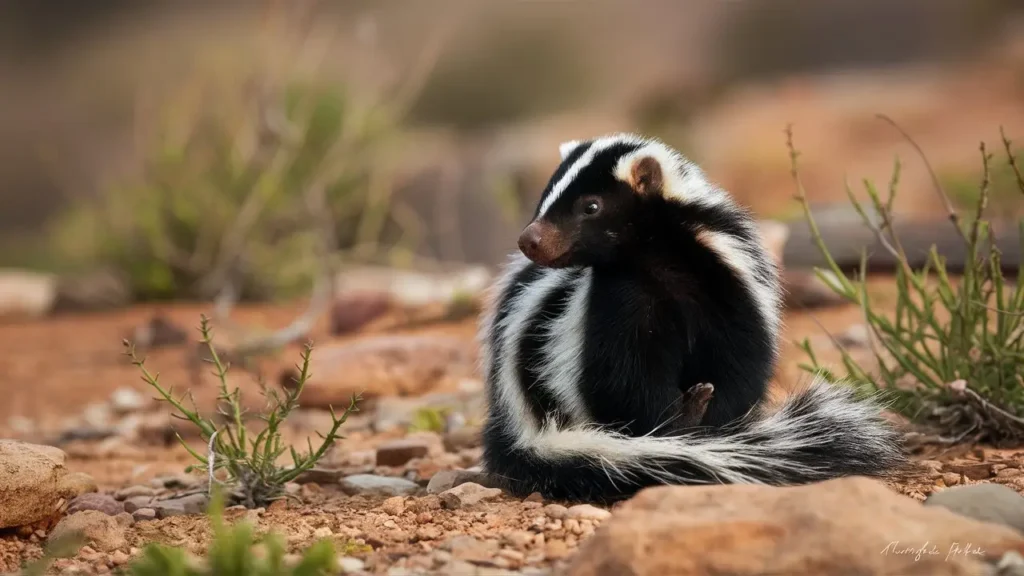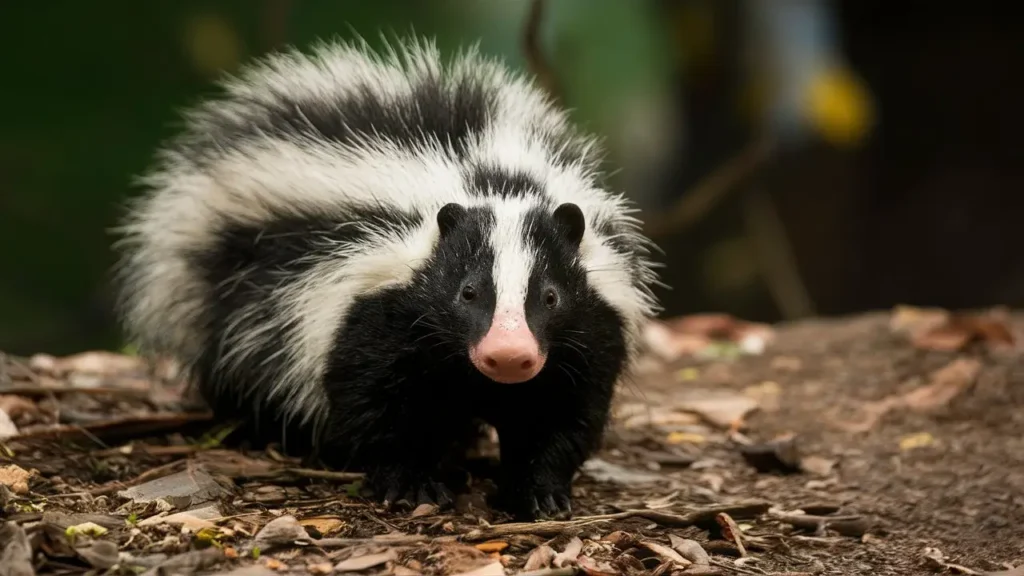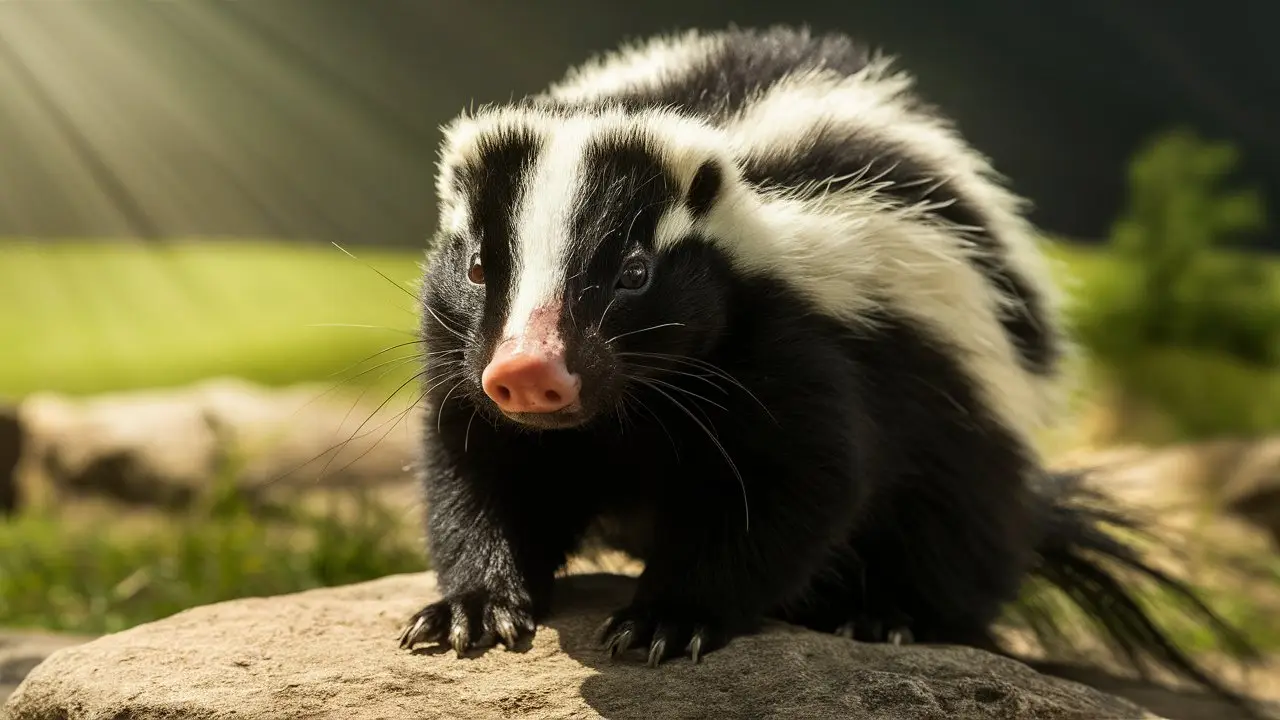Molina’s Hog-Nosed Skunk: A Unique South American Forager
Last updated on December 6th, 2024 at 11:10 pm
The Molina’s hog-nosed skunk (Conepatus chinga) is a remarkable creature native to South America. Known for its distinct snout and striking black-and-white fur, this skunk uses its specialized nose to root through the ground for food. Solitary and resourceful, it plays a crucial role in its ecosystem, contributing to pest control and seed dispersal. Let’s explore the fascinating world of this nocturnal animal.
Introduction to Molina’s Hog-Nosed Skunk
Molina’s hog-nosed skunk is named after naturalist Juan Ignacio Molina, and its unique features make it stand out among skunks. Its hog-like snout is perfectly designed for digging, allowing it to uncover hidden prey. With its black fur and bold white stripe, this skunk adds to the diversity of South America’s wildlife.
Physical Characteristics
Size and Appearance
Molina’s hog-nosed skunks are medium-sized mammals with a distinctive look:
- Length: 40–70 cm (16–28 inches), including their bushy tail.
- Weight: 1.5–4 kg (3.3–8.8 pounds).
- Fur: Predominantly black with a white stripe that starts at the head and splits along the back.
- Snout: A pink, hog-like nose ideal for rooting through soil.
Adaptations for Survival
These skunks have evolved features that help them thrive:
- Strong Legs and Claws: Perfect for digging into soil and breaking into insect nests.
- Powerful Spray: A sulfur-based chemical that deters predators and can reach up to 15 feet.
- Sensitive Nose: Detects food hidden underground with remarkable precision.
Behavioral Traits
Solitary Lifestyle
Molina’s hog-nosed skunks are solitary creatures. They roam alone except during the mating season. Mothers raise their young alone, teaching them essential survival skills before they venture out independently.
Defensive Behaviors
Their black-and-white fur serves as a warning to potential threats. When faced with danger, they:
Use their agility to escape if possible.
Stomp their feet and raise their tail as a warning display.
Spray a noxious odor, deterring even the most persistent predators.

Habitat and Range
Geographic Range
Molina’s hog-nosed skunks inhabit much of South America, with populations found in:
- Southern Brazil
- Uruguay
- Northern Argentina
- Parts of Paraguay and Bolivia
Preferred Habitats
These skunks are adaptable and can thrive in various environments:
- Grasslands: Ideal for foraging.
- Wooded Areas: Provide shelter and protection.
- Shrublands: Offer hiding spots from predators.
- Near Water Sources: Necessary for hydration and food availability.
They can also adapt to human-altered landscapes if food and shelter are accessible.
Diet and Foraging
Foraging Patterns
As nocturnal foragers, Molina’s hog-nosed skunks are active at night, relying on their strong sense of smell to locate food. They methodically explore their home ranges in search of sustenance.
Diet Composition
These omnivorous skunks have a varied diet that includes:
- Insects: Beetles, larvae, and ants.
- Small Vertebrates: Rodents, frogs, and lizards.
- Fruits and Berries: Provide essential nutrients.
- Plant Material: Leaves and roots when other food is scarce.
Their diet changes with seasonal availability, ensuring they always find enough to eat.

Reproduction and Lifecycle
Breeding Season
Molina’s hog-nosed skunks mate during late winter to early spring. Males actively search for mates, engaging in brief courtships.
Offspring Development
- Gestation Period: Approximately 60 days.
- Litter Size: Typically 2–5 kits.
- Weaning: Kits are weaned after two months and begin foraging alongside their mother.
- Independence: By four months, young skunks leave to establish their own territories.
This lifecycle ensures the continuation of the species while maintaining balance in their ecosystems.
Ecological Role
Molina’s hog-nosed skunks contribute significantly to their ecosystems:
- Pest Control: By consuming insects and small vertebrates, they help regulate populations of potential agricultural pests.
- Seed Dispersal: Consuming fruits aids in spreading seeds, promoting forest growth.
- Soil Aeration: Their digging activities improve soil health, benefiting plant life.
Conservation Status
Threats
While Molina’s hog-nosed skunks are not currently endangered, they face several challenges:
- Habitat Loss: Deforestation and urbanization reduce their natural environments.
- Pollution: Pesticides and other chemicals can poison their food sources.
- Hunting: Targeted for their fur or as perceived pests.
Conservation Efforts
Efforts to protect these skunks include:
- Protected Areas: Establishing reserves and national parks.
- Research: Studying their behavior and ecological roles.
- Education: Teaching local communities about the importance of skunks in maintaining ecological balance.
Fun Facts About Molina’s Hog-Nosed Skunk
- Long-Distance Sprayers: Their defensive spray can reach targets up to 15 feet away.
- Solitary Wanderers: Unlike many mammals, they prefer solitude except during mating season.
- Picky Eaters: They use their sensitive noses to select the best food options.
- Named After a Naturalist: The species honors Juan Ignacio Molina, who first documented them.
- Masters of Adaptation: They can thrive in grasslands, forests, and even near human settlements.
Frequently Asked Questions
What do Molina’s hog-nosed skunks eat?
They eat insects, small vertebrates, fruits, and plant material, adapting their diet to seasonal changes.
Where do Molina’s hog-nosed skunks live?
They are found in South America, inhabiting grasslands, forests, and shrublands, particularly in Brazil, Uruguay, Argentina, Paraguay, and Bolivia.
How do Molina’s hog-nosed skunks defend themselves?
They use a sulfur-based spray as a powerful deterrent, often warning predators first with stomping and tail-raising displays.
Conclusion
Molina’s hog-nosed skunk is a vital part of South America’s ecosystems. With its unique physical traits, fascinating behaviors, and ecological importance, this skunk reminds us of the intricate balance of nature. By protecting these animals and their habitats, we contribute to preserving the biodiversity that makes our planet extraordinary.a’s hog-nosed skunk opens a window into its unique existence. These creatures play a vital role in their ecosystems. By appreciating their quirks and survival tactics, we deepen our connection with the natural world.

